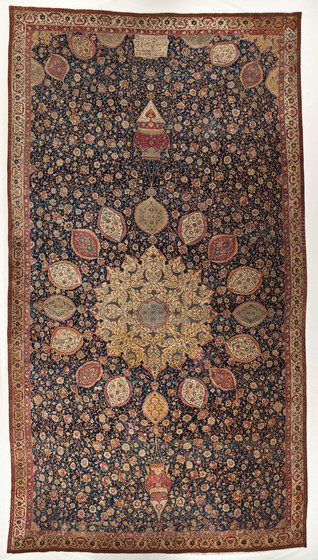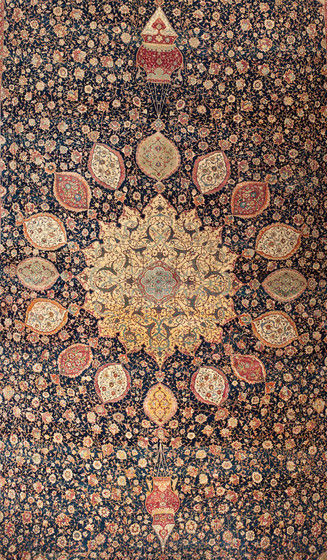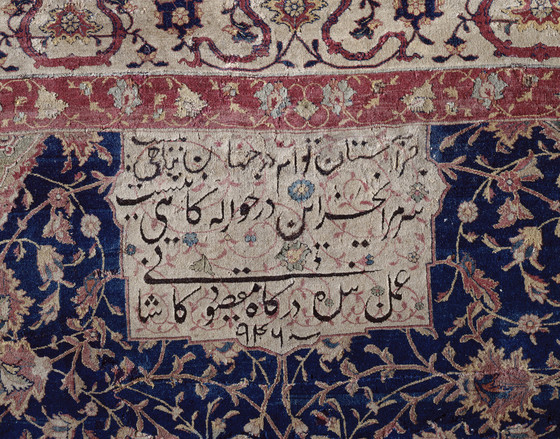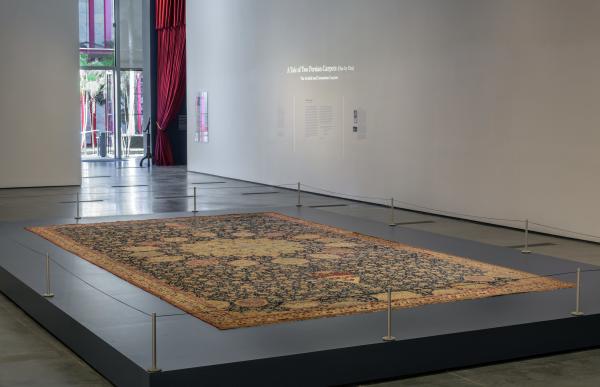Honestly, being able to surprise a Middle Easterner with a new carpet design is not a very easy task. As an Iranian, born and raised in a traditional household, I can attest that no matter if a carpet is new or old, common or rare, somehow Persians can always recognize the design from the many other carpets we have seen throughout our lives. For us, carpets are more than just a woven fabric that covers one’s living room floor. It is an essential part of any Iranian home and the home is the most essential part of Persian life. We sit on the carpets during formal or informal gatherings. We dine on them, sleep on them—we basically live on them. The carpet is interwoven with our everyday experiences.
Believe it or not, my very first vivid childhood memory is the design of my parents’ living room carpet and I am sure I am not the only one with such a memory. I remember the long hours of playing house on that carpet with my sister. We would each pick a corner of the carpet, our own niche covered in beautiful, ornate details that in our minds had become our cozy little homes. We would imagine that we were living with our imaginary children and handsome husbands, whose fathers were George Washington and Walt Disney. To see each other, we would crawl over the brown range of almost-impassable mountains, swim inside the serpentine blue and green rivers, and walk a long path through the winding patterned roads. Yet thanks to the glorious medallion in the center of the carpet acting as our imaginary bazaar, our meet-ups didn’t have to be that difficult every time we wanted to see each other.

In my adult years, as an art history student and later as a museum professional, I gained more academic exposure to Persian carpets, constantly studying and reading about them. My frequent visits to Tehran’s Carpet Museum convinced me that I had seen the best of the best, until the morning of September 14, 2017 in Los Angeles. That was when the Ardabil Carpet, now displayed in the Resnick Pavilion at LACMA, was unrolled for installation. I then realized you have to be in Los Angeles (or London, where the twin of the Ardabil Carpet is located) in order to view the most beautiful Iranian-made carpets. The majestically large size of the carpet, which correlates directly to the wealth of its commissioner, was the first thing to grab my attention. Awestruck, I walked around this magnificent carpet, deeply absorbed in the elaborate vegetative and floral patterns covering the rug. It felt as if I was walking through one of Iran’s traditional, lush gardens with a geometric pool in the center. The carpet’s unusually high knot-count of 35 million interlocked wool threads, dyed with naturally substances, allowed these intricate, precise designs and added to my wonder. Yet the two unique mosque lamps flanking both sides of the central golden medallion puzzled me. Was I looking at the floor or the ceiling of a mosque?

Beyond its physical perfection, the history of the carpet is nothing short of astonishing, especially for Iranians. This carpet was made during the Safavid dynasty (1501–1736), known for its significant patronage of art. The Safavid rulers commissioned exquisite objects and buildings, from mosques and palaces, to illustrated books and textiles. The Safavids have also left their mark in the present era by establishing Shi’a Islam as the state religion in Iran.

This carpet, along with its identical twin which now belongs to London’s Victoria & Albert Museum, were probably commissioned by the great art patron Shah Tahmasp (r.1525–1578), the second Safavid ruler, who likely gifted the two carpets to the shrine of the Sufi leader, Sheikh Safi al-Din Ardabili (1252–1334) in the city of Ardabil in northwestern Iran. Dated 946 AH or 1539–1540 CE, they are the earliest signed carpets produced in the Islamic art world and both carry the name of Maqsud Kashani, presumed to be the court official in charge of producing the carpets, who gave himself the title “the humble servant of the court.” Woven into the carpet above his signature are two hemistiches by the famous Persian poet Hafez, which read: "I have no refuge in this world other than your threshold, My head has no resting place other than this doorway.” I caught my breath when I saw this verse. I have later witnessed other Iranians viewing this carpet and getting excited when they spotted the verse.
Hafez has a huge influence in the daily life of Iranians. Regardless of his sophisticated language in its high standard poetic form, his verses are used frequently in daily conversation. There is a Persian expression that there are two books in every Iranian household, the Qu’ran and a collection of Hafez’s poetry. His poetry is also used for telling fortunes. With a question in mind, the believers open Hafez’s book to a random page, and the first line that catches their eye will reveal the answer.
Years ago, Linda Komaroff, LACMA’s curator of Islamic art, referred to the Islamic objects in LACMA’s collection as ambassadors of sorts, representing their countries or cultures of origin in the United States. If I were to ever choose a work of art as Iran’s ambassador, it would undoubtedly be the Ardabil Carpet, for it fulfills the task threefold: physically, due to its magnificent production; historically, as it was produced at a turning point in Iranian history; and metaphysically, for its link to Sufi and Persian mysticism. Still, even as an adult, I can envision myself making my home in the corner of the carpet closest to Hafez’s poetry, where I could seek refuge and rest my head.
Visit the Ardabil Carpet in the Resnick Pavilion through February 11, 2018, and come back to see the Coronation Carpet, which will be on view February 17–July 8, 2018.



